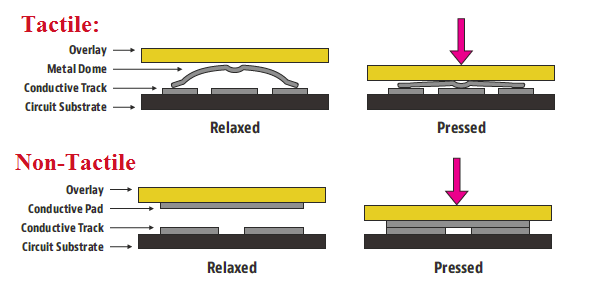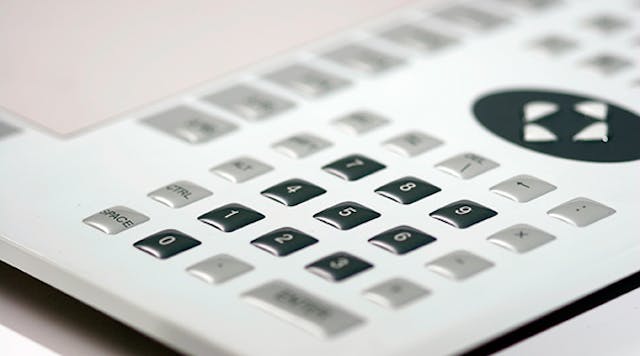Comprehending the Relevance of Membrane Switches in Interface
Membrane buttons are important parts in the style of efficient customer interfaces, facilitating not only performance but also enhancing visual allure and individual communication. As we discover the various benefits and future patterns linked with Membrane modern technology, it becomes clear that these buttons are much more than just parts; they stand for a convergence of development and functionality.
What Are Membrane Switches?

The spacer layer, which has sticky buildings, enables the separation of the circuit layer from the overlay, making certain that the switch continues to be in a non-activated state till pressed. When pressure is used to the overlay, it presses the spacer layer, connecting the space and completing the circuit in the underlying layer. This design not only decreases the physical space required for conventional mechanical buttons however additionally boosts the sturdiness of the device, as Membrane switches are normally resistant to dirt, dampness, and other ecological elements.
Frequently located in applications ranging from customer electronics to clinical tools, Membrane buttons are indispensable to modern technology, giving a straightforward and efficient user interface that straightens with contemporary style needs.
Advantages of Membrane Switches
While various button modern technologies exist, Membrane Switches offer distinct advantages that make them particularly preferable in numerous applications. Among the key benefits of Membrane buttons is their portable layout, which permits space-saving applications in devices where realty is limited. Their slim account not just boosts aesthetic charm yet likewise promotes light-weight building.
An additional significant advantage is their resistance to ecological variables. Membrane buttons are typically sealed versus moisture, dirt, and pollutants, making them excellent for use sought after settings, such as clinical tools and commercial devices. This toughness extends the life-span of the button, decreasing maintenance expenses and enhancing integrity.
Additionally, Membrane switches can be personalized to satisfy details design requirements, incorporating one-of-a-kind graphics and colors that boost customer communication. Their responsive responses options can additionally be customized to provide a rewarding individual experience. Furthermore, Membrane switches are cost-effective, specifically in high-volume applications, as they can be produced efficiently.
Applications in Different Industries

In the customer electronics field, Membrane switches prevail in gadgets such as microwaves, washing makers, and remotes. Their responsive responses and visual options boost user experience while giving a smooth, modern appearance. In addition, auto producers make use site here of Membrane switches in control panel controls and infotainment systems, where area is restricted, and user involvement is critical.
Additionally, the industrial market leverages Membrane switches in control panels for machinery and equipment, enabling instinctive operation in often harsh settings. Their resistance to chemicals and dampness makes sure durability and reliability in these applications. Overall, the flexibility of Membrane Switches adds significantly to their extensive use, making them important in various technological domain names.
Layout Factors To Consider for Membrane Buttons

When making Membrane switches, a number of key considerations have to be thought about to make sure ideal performance and user experience. The choice of products is crucial; choosing durable, high-grade substratums can improve the switch's long life and resistance to ecological factors such as dampness and temperature level changes.
Secondly, the layout of the graphic overlay should focus on clearness and simplicity of use. Symbols and message must be readable, and the format should help with user-friendly communication (membrane switches). Additionally, tactile responses is essential; incorporating a tactile dome or various other systems can boost the customer experience by giving physical verification of activation
An additional crucial variable is the button's electrical efficiency. Designers have to guarantee that the conductive traces are appropriately created to reduce resistance and avoid signal interference. This entails evaluating the needed actuation force and guaranteeing compatibility with the digital parts they will user interface with.

Future Trends in Membrane Modern Technology
As modern technology remains to advance, Membrane switches are positioned to advance substantially, driven by advancements in products and manufacturing methods. One emerging pattern is the unification of innovative materials, such as conductive inks and adaptable substratums, which enhance durability and decrease the overall weight of Membrane buttons. These materials not just enhance the responsive feedback however also enable for the layout of switches that can withstand harsher ecological problems.
Additionally, the integration of touch-sensitive modern technologies is changing standard Membrane Switches into even more interactive user interfaces. Capacitive touch sensors installed within Membrane switch panels can offer a more responsive and intuitive customer experience, aligning with the growing demand for streamlined, article source modern designs in customer electronic devices.
Furthermore, innovations in printing techniques, such as digital and 3D printing, enable rapid prototyping and customization of Membrane switches. This versatility enables suppliers to respond much more quickly to market demands and consumer preferences.
Lastly, sustainability is becoming a substantial focus, with manufacturers checking out green products and procedures. As these trends unfold, the future of Membrane innovation guarantees improved capability, visual allure, and environmental obligation, solidifying their function in sophisticated individual interfaces across different sectors.
Conclusion
In conclusion, Membrane Switches stand for an important part in the layout of customer interfaces, combining functionality with aesthetic versatility. As developments in innovation proceed, the evolution of Membrane switches is expected to further refine customer interfaces, driving innovation and boosting use in a progressively complicated technical landscape.
Membrane switches are essential parts in the style of efficient read the article user interfaces, facilitating not just capability but additionally enhancing visual charm and individual communication.Membrane Switches offer as a crucial part in numerous user interfaces, facilitating a smooth interaction in between individuals and electronic devices.While countless button modern technologies exist, Membrane Switches deal unique benefits that make them specifically preferable in various applications.Moreover, Membrane switches can be customized to satisfy specific style needs, including unique graphics and shades that boost customer interaction.In verdict, Membrane Switches represent a vital element in the layout of individual interfaces, combining capability with visual flexibility.
Comments on “How Membrane Switches Are Designed for Easy Maintenance and Repair”